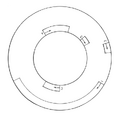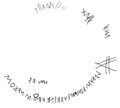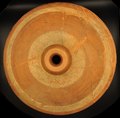VB·3.1
| Inscription | |
|---|---|
| Reading in transliteration: | latumarui : sapsutai : pe : uinom : natom |
| Reading in original script: | |
| Variant reading: | latuśarui : sapsutai : pe : uinoś : natoś naśom naxom |
|
| |
| Object: | VB·3 Ornavasso (bottle) (Inscriptions: VB·3.1, VB·3.2, VB·3.3, VB·3.4, VB·3.5) |
| Position: | shoulder, outside |
| Orientation: | 0° |
| Direction of writing: | sinistroverse |
| Script: | North Italic script (Lepontic alphabet) |
| adapted to: | Latin script |
| Letter height: | 0.6–1 cm0.236 in <br />0.394 in <br /> |
| Number of letters: | 29 |
| Number of words: | 5 |
| Number of lines: | 1 |
| Workmanship: | scratched after firing |
| Condition: | complete |
|
| |
| Archaeological culture: | La Tène D [from object] |
| Date of inscription: | first half of 1st c. BC [from object] |
|
| |
| Type: | dedicatory |
| Language: | Celtic |
| Meaning: | 'for Latumaros and Sapsuta Naxian wine' (?) |
|
| |
| Alternative sigla: | Whatmough 1933 (PID): 304 Tibiletti Bruno 1981: 10 Solinas 1995: 128 1 Morandi 2004: 48 A |
|
| |
| Sources: | Morandi 2004: 550–552 no. 48 A |
Images
|
| ||||
Commentary
First published in Bianchetti 1895: 69, 145, no. 7.
Images in Tibiletti Bruno 1966: 12 (photo) and 13 (drawing), Solinas 1995: tav. LXXII (photo), Morandi 1999: 170 (drawing) and Morandi 2004: 548, fig. 11.46 (drawing).
Main inscription, applied around the shoulder above one of the white painted bands. Lattes 1896 perfect reading, includes stroke under the last ![]() and interprets the letter as a variant of san for [χs] as in Voltino saśadis, compares the ending of latumarui to that of the pala-stelae -> 'Naxian wine of Latumaros and Sapsutaipis', inscribed for a libation ritual during the burial. Featured in the genitive vs. dative debate: Kretschmer 1905: 99–101, no. 20, agrees in principle (and notes the absence of /i/ in naśom), but segments sapsutai-pe with enclitic conjunction. Hirt 1905–1907: 564 f. dative (also Hirt 1917: 210 f.), Danielsson 1909: 18 f. in agreement (but, following Torp, doubts the Naxian wine, and interprets the text as a gift inscription), also Rhŷs 1913: 63–67, no. 20 ('to/for Latumaros and Sapsuta Naxian wine', and naxom is "reduced"), but interprets the third-to-last letter as Latin
and interprets the letter as a variant of san for [χs] as in Voltino saśadis, compares the ending of latumarui to that of the pala-stelae -> 'Naxian wine of Latumaros and Sapsutaipis', inscribed for a libation ritual during the burial. Featured in the genitive vs. dative debate: Kretschmer 1905: 99–101, no. 20, agrees in principle (and notes the absence of /i/ in naśom), but segments sapsutai-pe with enclitic conjunction. Hirt 1905–1907: 564 f. dative (also Hirt 1917: 210 f.), Danielsson 1909: 18 f. in agreement (but, following Torp, doubts the Naxian wine, and interprets the text as a gift inscription), also Rhŷs 1913: 63–67, no. 20 ('to/for Latumaros and Sapsuta Naxian wine', and naxom is "reduced"), but interprets the third-to-last letter as Latin ![]() with a diacritic understroke
with a diacritic understroke ![]() to distinguish it from Lepontic
to distinguish it from Lepontic ![]() (also Rhŷs 1914: 25 f.). Whatmough PID: 111–113, no. 304 (a) same, but judges
(also Rhŷs 1914: 25 f.). Whatmough PID: 111–113, no. 304 (a) same, but judges ![]() to be a "normal" form of san (compares MI·1 peśu, which nota bene is petu); notes that the second letter has a superfluous scratch too. Pisani 1964: 286 f., no. 124 (a): marriage gift. Something different: Tibiletti Bruno 1975: 55 latuśarui, reading Latin
to be a "normal" form of san (compares MI·1 peśu, which nota bene is petu); notes that the second letter has a superfluous scratch too. Pisani 1964: 286 f., no. 124 (a): marriage gift. Something different: Tibiletti Bruno 1975: 55 latuśarui, reading Latin ![]() as san; in greater detail Tibiletti Bruno 1978: 144–146 also uinoś natoś as acc.pl. 'to L. and S. beautiful children'.
as san; in greater detail Tibiletti Bruno 1978: 144–146 also uinoś natoś as acc.pl. 'to L. and S. beautiful children'.
See also Giussani 1902: 55–57, Jacobsohn 1927: 31, no. 192.
- Lejeune 1987: pp. 493-508, fn. on p. 493
- Meid 1999: pp. 15, fn. 24
- Lambert 1994: pp. 21
- Pellegrini 1983: pp. 36-37
- Tibiletti Bruno 1981: pp. 162-164, n.10
- Birkhan 2005
- Piana Agostinetti 1972: p.272, n.12, Tav. XXXI, n.12
- Solinas 1995: p. 375, n.128, Tavv. LXIXb, LXX a-d and LXXI a-b
- Piana Agostinetti 1997–1999: pp. 69 and 145 of Volume 1 and p. 57 of Volume 2
- Morandi 1999: p. 172, n.17, Pl. IX, 1
- Morandi 1999b: pp. 308-312, n.4
Bibliography
| Bianchetti 1895 | Enrico Bianchetti, I sepolcreti di Ornavasso [= Atti della Società di Archeologia e Belle Arti della provincia di Torino 6], Torino: Paravia 1895. |
|---|---|
| Birkhan 2005 | Helmut Birkhan, "UINOM NAŚOM", in: Franziska Beutler, Wolfgang Hameter (Eds.), "Eine ganz normale Inschrift" ... Vnd ähnLiches zVm GebVrtstag von Ekkehard Weber. Festschrift zum 30. April 2005 [= Althistorisch-Epigraphische Studien 5], Wien: Eigenverlag der Österreichischen Gesellschaft für Archäologie 2005, 223-228. |
| Caramella & De Giuli 1993 | Pierangelo Caramella, Alberto De Giuli, Archeologia dell'Alto Novarese, Mergozzo: Antiquarium Mergozzo 1993. |
| Danielsson 1909 | Olof August Danielsson, Zu den venetischen und lepontischen Inschriften [= Skrifter utgivna av Kungliga Humanistiska Vetenskaps-Samfundet i Uppsala 13.1], Uppsala – Leipzig: 1909. |







